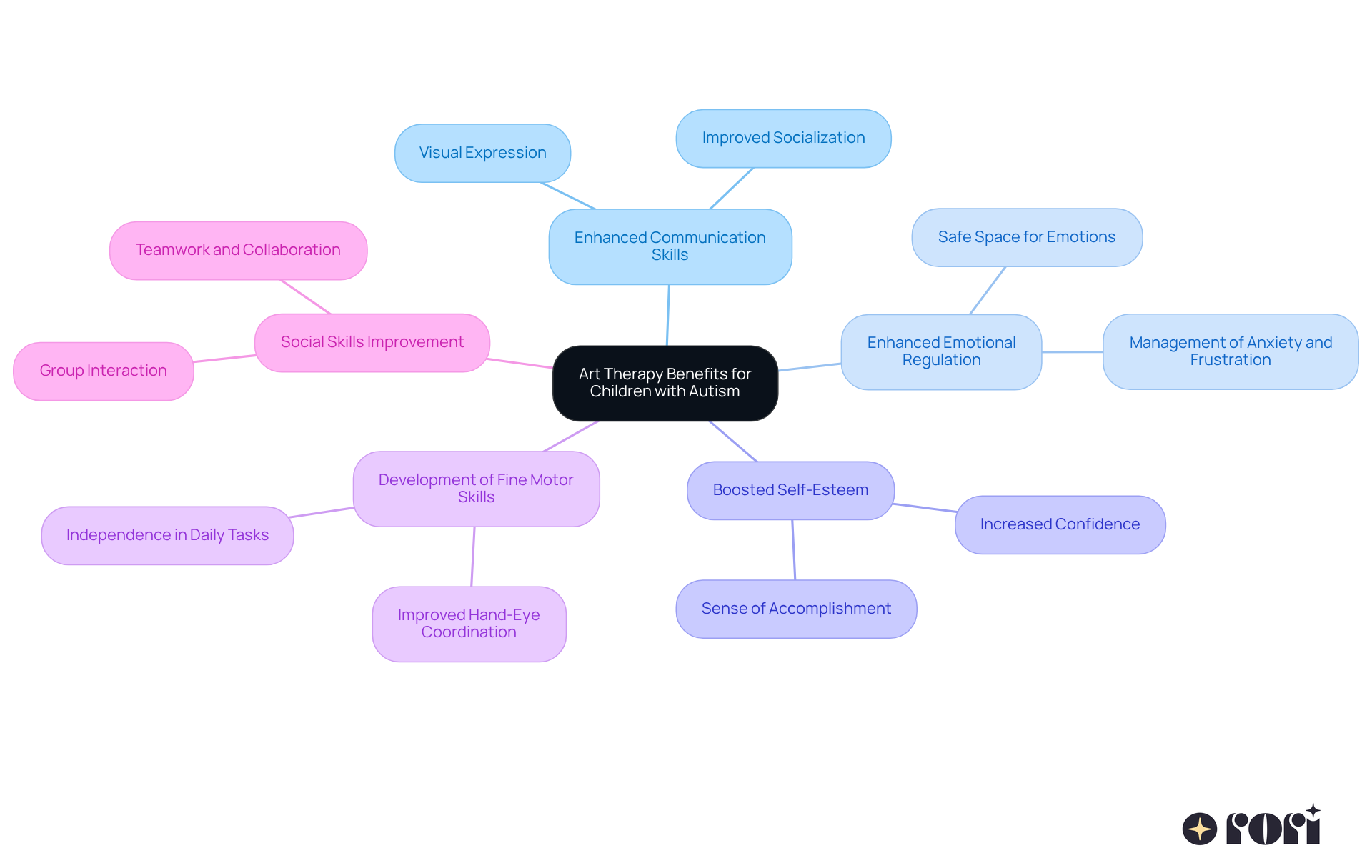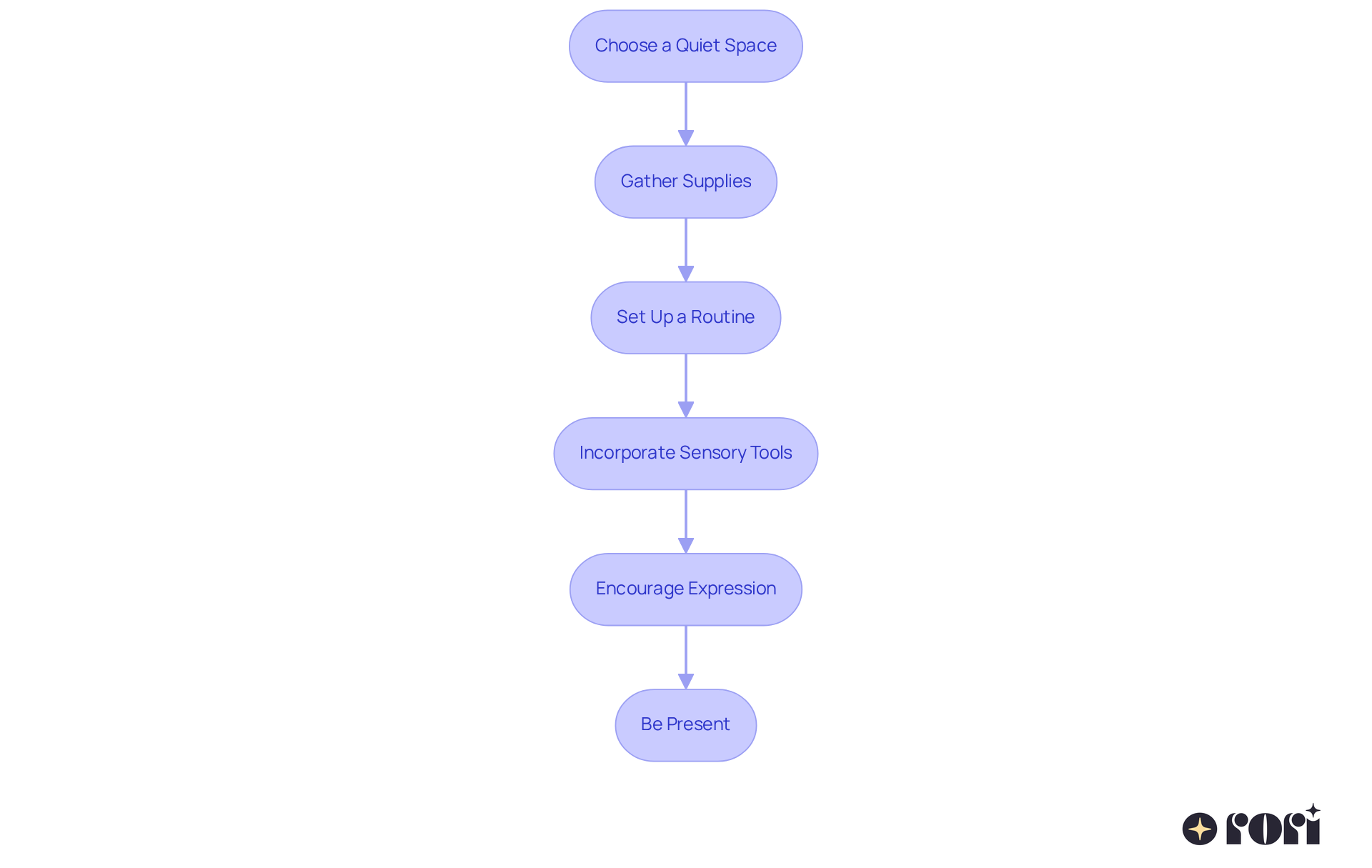Art therapy has become a wonderful tool for children with autism, offering a special way for them to express themselves and explore their emotions. This creative approach not only helps improve communication skills but also supports emotional regulation and boosts self-esteem. For parents, it’s an invaluable resource in nurturing their children’s development.
Yet, diving into art therapy can feel a bit overwhelming at times. Many parents find themselves wondering how to effectively bring these techniques into their homes. What strategies can you use to create a nurturing environment that encourages artistic expression while also tackling any challenges that might arise?
Let’s explore this together! By sharing experiences and insights, we can build a supportive community that empowers each other on this journey.
Art therapy as a tool for self-expression in autism provides a creative way for individuals to express themselves and explore their emotions through artistic processes. For children with autism, this therapy offers a valuable non-verbal outlet for self-expression, leading to numerous benefits:
At Rori Care, we understand how important it is to combine art treatment with other supportive services like Group Sessions, Individual Counseling, Caregiver Education, Program Development, and Supervision. These services work together to provide comprehensive support for families, helping them overcome challenges and promote youth development with expertise and compassion. By recognizing these benefits, parents can appreciate how art therapy as a tool for self-expression in autism serves as a powerful resource in nurturing their children's growth and emotional wellness, paving the way for better communication and social skills.
As Dr. Hugh D. R. Baker wisely noted, "A family is, of course, moulded by its relationships with other families and with society at large, just as the behaviour and lifestyle of the individual are affected by his relationships with others." This really highlights the importance of supportive measures like art-based assistance in fostering healthy development.
Let’s explore this together! We’re here to help you every step of the way!

Preparing your child for art therapy can be a rewarding journey! Here are some friendly steps to help you create a supportive environment:
Choose a Quiet Space: Find a calm corner in your home where your little one can focus on their art without distractions. Whether it’s a cozy art nook or a quiet room, a peaceful setting can work wonders.
Gather Supplies: Stock up on a variety of art materials like crayons, markers, paints, and paper. Let your child pick their favorites! This not only sparks excitement but also gives them a sense of ownership.
Set Up a Routine: Establish a regular schedule for art therapy sessions. Predictability can help your child feel more secure and ready to dive into creativity. Research shows that a stable routine can significantly reduce anxiety for kids, especially those with autism. It aligns beautifully with the principles of Applied Behavior Analysis (ABA), emphasizing the importance of early intervention for boosting learning and social skills. Plus, the behavior care engine tailors plans after each session based on progress, ensuring therapy stays personalized.
Incorporate Sensory Tools: Think about adding sensory-friendly items like textured paper or scented markers. Engaging their senses can make the creative experience even more enjoyable and help them feel at ease.
Encourage Expression: Remind your child that there are no right or wrong ways to create art. Encourage them to express their feelings freely! The process is what truly matters. As Laura NG, Clinical Operations Manager, wisely says, "Routine provides a sense of predictability, making the environment more understandable and less stressful." This approach nurtures creativity and aligns with adaptive treatment plans that evolve with progress.
Be Present: Join your child during art sessions! Your support can make a world of difference, helping them feel more comfortable and confident in their creative expression. By understanding ABA principles, you can positively influence your child’s behavioral goals.
By following these steps, you’re creating a nurturing space that encourages your child to explore their creativity and emotions through art therapy as a tool for self-expression in autism. This not only enhances their communication and social skills but also reinforces the importance of caregiver involvement. Let’s explore this together!

Here are some simple art therapy activities you can try at home, all backed by Rori Care's commitment to neurodiversity and children's success:
Emotion Wheel Drawing:
Nature Collage:
Self-Portrait Painting:
Story Stones:
Music and Art:
These activities not only spark creativity but also provide opportunities for emotional expression and communication, showcasing art therapy as a tool for self-expression in autism, which makes it a wonderful resource for your child's development. Participating in these activities, including art therapy as a tool for self-expression in autism, can significantly enhance emotional regulation and social skills, which are vital for individuals with autism. Creating a supportive environment for these activities is key; make sure the space is comfortable and free from distractions to maximize engagement. Let’s explore this together!

Art therapy as a tool for self-expression in autism can provide a wonderful experience for young individuals, but let’s be real—parents often face some hurdles along the way. Here are a few common challenges and some friendly strategies to help you navigate them:
Resistance to Participation:
Sensory Overload:
Difficulty Expressing Emotions:
Frustration with Art Materials:
Short Attention Span:
By addressing these challenges with thoughtful solutions, you can create a more enjoyable and effective experience using art therapy as a tool for self-expression in autism for your child. This not only enhances their self-expression but also supports their emotional well-being. Let’s explore this together!

Art therapy shines as a wonderful tool for self-expression in children with autism, giving them a special way to communicate and explore their feelings creatively. By tapping into artistic processes, this approach not only helps improve communication skills but also nurtures emotional regulation, boosts self-esteem, and encourages social interactions. Integrating art therapy into the lives of these children can truly enrich their developmental journey, allowing them to flourish both emotionally and socially.
You know, key insights from the article highlight how art therapy creates a safe space for kids to express their feelings, develop fine motor skills, and engage in meaningful social interactions. Parents play such an important role in this journey by fostering a supportive environment that encourages exploration and expression. Simple activities like drawing an emotion wheel or making nature collages can easily be done at home, reinforcing the idea that art therapy is a fantastic way to enhance emotional literacy and self-awareness.
Ultimately, we can’t underestimate the importance of art therapy for children with autism. It’s not just a powerful resource for self-expression; it also plays a vital role in their overall emotional well-being and social development. So, let’s embrace this creative journey together! By utilizing the strategies and activities shared, parents can create an enriching environment that empowers their children to express themselves freely. Together, we can help unlock the potential within our kids, paving the way for a brighter future filled with confidence and connection. Let’s explore this together!
What is art therapy and how does it benefit children with autism?
Art therapy is a creative tool that allows children with autism to express themselves and explore their emotions through artistic processes. It provides a non-verbal outlet for self-expression, leading to numerous benefits including enhanced communication skills, emotional regulation, boosted self-esteem, improved fine motor skills, and social skills improvement.
How does art therapy enhance communication skills in children with autism?
Art therapy helps children communicate by enabling them to convey their thoughts and feelings visually. This is particularly beneficial for those who struggle with verbal communication, as it can significantly boost their socialization and relational skills.
In what ways does art therapy support emotional regulation?
Engaging in artistic activities offers a safe space for children to process their emotions, helping them manage feelings of anxiety, frustration, or sadness. Studies have shown that art therapy can lead to meaningful improvements in emotional well-being.
How does completing art projects affect a child's self-esteem?
Completing art projects provides children with a sense of accomplishment and pride, which enhances their self-esteem. This boost in confidence is crucial for their overall development and encourages them to engage in social interactions.
What skills do children develop through art therapy?
Children develop fine motor skills through activities like drawing, painting, and sculpting, which improve hand-eye coordination. Additionally, group art sessions foster social skills by encouraging interactions, sharing, and collaboration among peers.
What additional services does Rori Care provide alongside art therapy?
Rori Care combines art therapy with other supportive services such as Group Sessions, Individual Counseling, Caregiver Education, Program Development, and Supervision to provide comprehensive support for families and promote youth development.
Why is it important to recognize the benefits of art therapy for children with autism?
Recognizing the benefits of art therapy helps parents appreciate its role as a powerful resource in nurturing their children's growth and emotional wellness, which can lead to better communication and social skills.